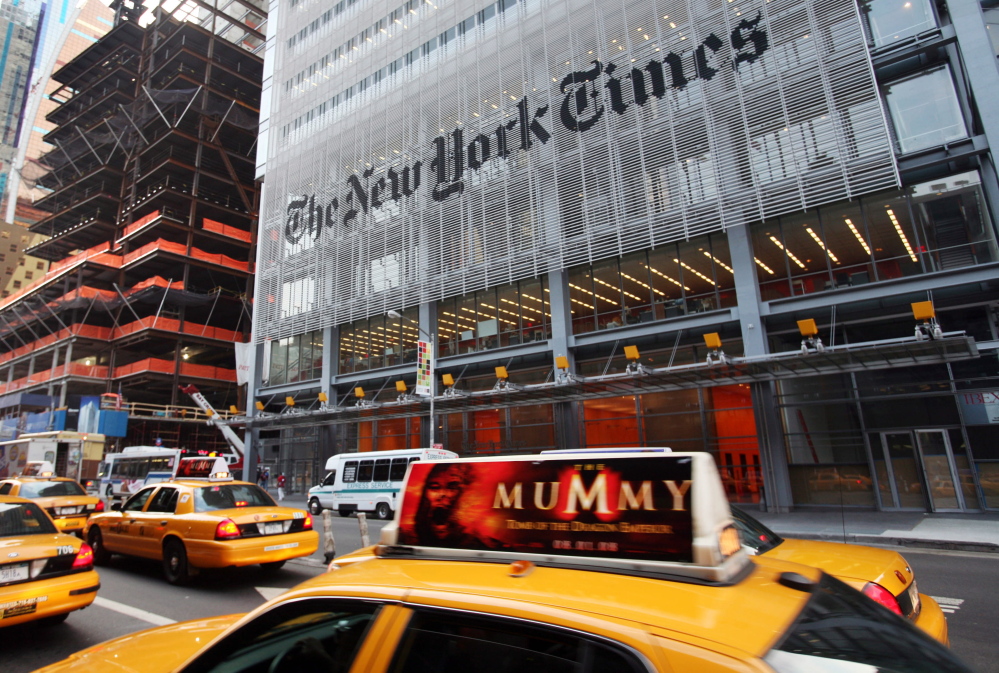NEW YORK — Billionaire Carlos Slim is poised to double his money after investing $250 million in a 2009 lending agreement with the New York Times, showing how dearly the newspaper’s owners paid for his help.
Slim, who controls mobile-phone carrier America Movil and is the world’s second-richest person according to data compiled by Bloomberg, already has earned $122 million from his loan to the Times, based on an annual interest rate of 14 percent and a 12 percent premium charged to the company when its debt to Slim was redeemed in 2011. Under the terms of the loan, the Times still owes Slim additional shares worth as much as $141 million based on the Jan. 17 stock price, thanks to options he received to buy shares at what is now a deep discount.
Slim’s loan to the Times gave the publisher time to sell some assets and bolster a digital-subscription strategy to offset slumping ad sales. The agreement with Slim required the parent New York Times Co. to accept terms that effectively reduced a stock market windfall five years later. By selling 15.9 million shares at a fraction of their market value, the company risked giving up more than $100 million it could raise through an offering to the public.
“The Times had financial issues when they borrowed money from Carlos Slim,” said Thomas Graham Kahn, president of Kahn Brothers Advisors, a Times Co. investor. “They’ve gone from a position of having to pay high interest rates on their loans to where they’re net cash-positive.”
Arturo Elias, a spokesman for Slim, declined to comment, as did Abbe Serphos, a spokeswoman for Times Co.
The 14 percent interest rate charged to Times Co. on Slim’s loan, which was announced Jan. 19, 2009, compared with the average bond yield of 13.41 percent that day for similarly rated borrowers on the Bank of America Merrill Lynch 1-to-10-Year BB U.S. High Yield Index. Standard & Poor’s rated Times Co. BB- at the time, three steps below investment grade. The publisher’s ranking is now one step lower at B+.
The interest on Slim’s loan was the highest rate Times Co. paid on debt dating back to at least 1995, according to data compiled by Bloomberg.
As of last week’s close, Slim’s profit from the loan stood at $263 million, including the loan’s interest and premiums and the warrants issued by Times Co. as part of the loan deal. They let Slim buy shares for $6.36 apiece, less than half Times Co.’s $15.22 close last week in New York trading. That gives Slim $8.94 in potential profit for each of the 15.9 million shares he’s allowed to buy.
The warrants expire on Jan. 15, 2015 — meaning Slim must make his move soon. The company has set aside the shares and is prepared to sell them whenever Slim exercises the warrants.
Times Co. gave Slim such a profitable deal because it found itself under pressure in early 2009, with a $400 million credit line months away from expiring. Rather than hurry to sell off businesses for cash amid the chaos of the global financial crisis, the company made the deal with Slim, giving it breathing room it used to eventually find buyers for units such as About.com and the Boston Globe.
The interest on Slim’s loan cost Times Co. about $35 million a year — more than double what it was paying in interest for the expiring credit line. By late 2010, the publisher was able to raise the money it needed to refinance Slim’s loan, issuing $225 million of six-year bonds with a more palatable 6.625 percent coupon.
While the loan paid a good interest rate, and the warrants offered the chance for a profit, Slim’s deal with Times Co. wasn’t without risk. Newspapers were hemorrhaging as the Internet provided competition for advertising. Times Co.’s sales had dropped 8 percent in 2008, and they continued to decline every year until 2012.
Still, Slim continued to express confidence in Times Co.’s management and its controlling owners, the Ochs-Sulzbergers. The family has turned things around by beginning to charge a subscription for online access, cutting costs and hiring an outside chief executive officer in Mark Thompson.
Thompson is determined to create new digital-subscription products while reorganizing the sales staff to buoy advertising revenue. Times Co. hit a five-year closing high of $16.09 at the end of last year.
“I don’t see why their earnings should not take them up to $20 a share in a few years,” said Kahn, whose firm holds 5.4 million Times Co. shares.
The company still faces a daunting task in vying for subscribers and advertising dollars, and only one out of nine analysts who cover the stock recommends buying it, according to data compiled by Bloomberg.
A $263 million return is still a drop in the bucket for Slim, whose $69.6 billion fortune puts him behind only Bill Gates among the world’s richest, according to the Bloomberg Billionaires Index. Slim, who turns 74 next week, gets most of his net worth from the companies he controls in Mexico, led by America Movil, Latin America’s biggest wireless company.
Besides his Times Co. stock warrants, Slim also holds 11.9 million shares of the company, mostly accumulated before the loan deal. He didn’t disclose what he paid for the bulk of that stock, making it difficult to calculate how much he has profited from the stake, though he has collected about $1 million in dividend payments.
What’s clear is that lending money to Times Co. helped the company recover from a low point, protecting that early investment.
If the billionaire chooses to exercise his warrants and keep the shares, he would own almost a fifth of Times Co. Slim’s loan in 2009 raised concerns that one of the most venerated U.S. newspapers would be beholden to the Mexican billionaire, who battles accusations of being a telecommunications monopolist in his home country. “Who is Carlos Slim, and does he want the paper of record?” read a headline in the New Yorker. “Let’s keep an eye on Senor Slim,” media columnist Jack Shafer wrote in Slate.
A takeover, however, is unlikely given the publisher’s dual-class share structure, which gives the Ochs-Sulzberger family a firm grip over the company’s board.
Slim is already the publisher’s second-largest shareholder with about 8 percent. His stake only allows him to vote for Class A directors, a group that represents no more than a third of the company’s board seats. The Ochs-Sulzberger family’s Class B shares let it elect the remaining two-thirds of the board, giving it effective and lasting control. Class B shares aren’t publicly traded.
Slim has consistently said he believed the publisher would overcome its struggles because its reputation and name recognition would help it survive the difficult transition from print to the Internet.
As he put it in a 2009 interview, “That is one of the best newspapers and brands in the world.”
With assistance from Patricia Laya in Mexico City.
Send questions/comments to the editors.




Success. Please wait for the page to reload. If the page does not reload within 5 seconds, please refresh the page.
Enter your email and password to access comments.
Hi, to comment on stories you must . This profile is in addition to your subscription and website login.
Already have a commenting profile? .
Invalid username/password.
Please check your email to confirm and complete your registration.
Only subscribers are eligible to post comments. Please subscribe or login first for digital access. Here’s why.
Use the form below to reset your password. When you've submitted your account email, we will send an email with a reset code.